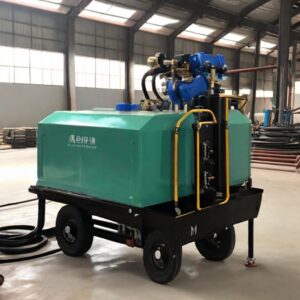In the world of protective coatings and surface treatments, polyurea has emerged as a frontrunner due to its remarkable properties such as rapid curing time, durability, and chemical resistance. Applying polyurea efficiently and effectively requires specialized equipment designed to handle its unique characteristics. Polyurea spraying equipment is revolutionizing the coatings industry by providing solutions that are fast, reliable, and yield long-lasting results.
Essential Components of Polyurea Spraying Equipment
Polyurea spraying equipment consists of several components, each playing an important role in the accurate and efficient delivery of the coating material.
The heart of polyurea spraying equipment is the proportioner, also known as the reactor. This sophisticated machinery heats and pumps the two reactive components of polyurea (the isocyanate and the polyol resin) at a precise ratio and temperature. Advanced systems ensure consistent pressure and volume control, key factors that affect the quality of the final coating.
Polyurea needs to maintain a specific temperature to ensure proper mixing and curing. Heated hoses transport the materials from the proportioner to the spray gun while maintaining the necessary temperature to avoid premature curing or poor mixing inside the hose.
The spray gun is the point of application, where the components mix and are sprayed onto the substrate. There are two main types of spray guns for polyurea application: mechanical purge and air purge. Both are designed to handle the rapid set time of polyurea, with features that prevent clogging and allow for easy maintenance.
Since polyurea components are typically stored in large drums, transfer pumps are used to feed the materials to the proportioner. Agitators can be used in the material drums to maintain a homogenous mixture, especially if fillers or pigments are part of the formulation.
Operating Principles of Polyurea Spraying Equipment

Polyurea spraying equipment operates on several foundational principles designed to ensure the efficient and effective application of polyurea coatings. These coatings are commonly used in various industries for waterproofing, corrosion protection, containment, and abrasion resistance due to their durability and quick-setting nature.
The equipment is engineered to maintain the isocyanate and resin (polyol) components of polyurea separate until the moment of application. This separation is necessary because once these components mix, they react swiftly to form the final polyurea coating. Each component is stored in its own drum or tank where a high-pressure pump forces it into a common heating system.
The proportioner or proportioning is important in the operation. It precisely meters the two components, ensuring they are delivered to the spray gun at exactly the right ratio, which is commonly a 1:1 volume ratio for many polyurea systems. This precise ratio is important because even slight deviations can compromise the integrity and performance of the resulting polyurea coating.
As the materials pass through the proportioner, they are also heated to an optimal processing temperature, often between 160-190 degrees Fahrenheit, or approximately 71-88 degrees Celsius. This temperature increase reduces the viscosity of the liquid components, making them easier to mix and spray, while also accelerating the reaction time once they are combined.
High-pressure, heated hoses are then used to transport the now pre-heated and pressurized components from the proportioner to the spray gun while maintaining their temperature. Maintaining the correct temperature during transit through the hoses is essential to ensure that the materials do not start to react or cool down, which would affect the quality of the mix and spray pattern.
At the point of application, the spray gun is where the magic happens. The two components are mixed together at very high pressures, often between 1,000 and 3,000 PSI, in the gun’s mixing chamber. This results in a spray that rapidly sets upon contact with the surface being coated. The spray gun is normally designed to mix the materials in an impingement manner, where the streams of each component collide with each other at high speed and under high pressure, which ensures a thorough mixing just before application.
The training and experience of the operator are paramount because polyurea’s rapid curing—often seconds to minutes—means there’s little room for error during application. The operator must manage the spraying process with skill, carefully controlling the substrate preparation, spray pattern, application thickness, and environmental conditions, among other factors, to ensure a successful, uniform application of the polyurea coating. Safety precautions must be rigorously observed due to the high temperatures and pressures involved, as well as the potential hazards from isocyanates in the formulation.
Latest Innovations in Polyurea Spraying Technology
The rapid advancement in polyurea technology has led to cutting-edge developments in spraying equipment. Some of the latest innovations include:
Advanced control systems that allow for precise adjustments of temperature and pressure for different polyurea formulations.
User-friendly interfaces that simplify the setup and monitoring processes for operators.
Integration of data collection systems that track the usage and performance, aiding in maintenance and operation efficiency.
Development of portable spraying systems making polyurea applications feasible in remote locations without sacrificing the quality of the application.
Choosing the Right Polyurea Spraying Equipment
Selection of polyurea spraying equipment depends on various factors, including the scale of projects, type of polyurea being applied, and specific application requirements.
Compatibility with various polyurea formulations, as different projects may require different material properties.
The capacity of the equipment, ensuring that it can handle the volume of work.
Durability and ease of maintenance, since the equipment must perform in harsh environments and withstand the abrasive nature of polyurea materials.
While the application of polyurea coatings is often performed in a straightforward manner, safety should never be an afterthought. Operators should be equipped with personal protective equipment (PPE), including respirators, goggles, and disposable coveralls.
